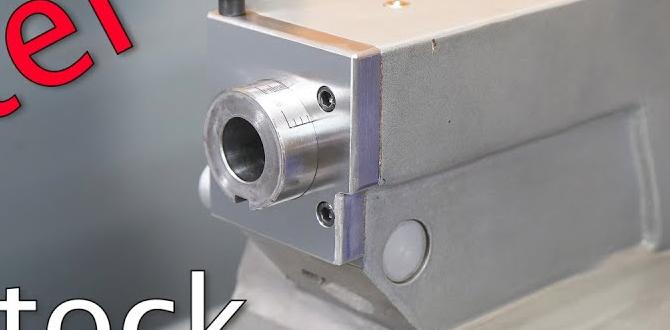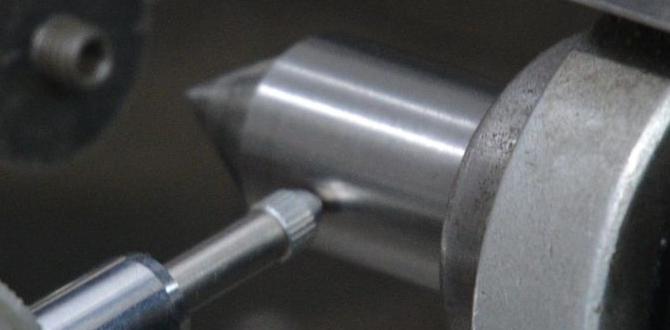Carbide end mills are genius for machining HRC60 steel, offering superior hardness and heat resistance that makes them ideal for this challenging material. Learn how to select and use them effectively for precise results.
Milling HRC60 steel can feel like trying to carve granite with a butter knife. It’s incredibly hard, wears down standard tools quickly, and generates a lot of heat. This often leaves beginners frustrated, with dull tools and poor finishes. But what if there was a tool specifically designed to tackle this toughness head-on? That’s where the carbide end mill shines. We’re going to break down exactly why these tools are so special for hardened steel and how you can use them confidently in your workshop.
Why HRC60 Steel is So Tough (And Why You Need Special Tools)
Before we dive into the magic of carbide, let’s quickly touch on why HRC60 steel is such a beast. HRC stands for Rockwell Hardness C, and 60 is a very high number on this scale. This means the steel has been heat-treated to become extremely hard. This hardness is fantastic for wear resistance and strength, which is why it’s used for things like punches, dies, high-precision molds, and cutting tools themselves.
However, this extreme hardness comes with a catch: it’s very brittle and generates immense heat when machined. Traditional High-Speed Steel (HSS) tools simply can’t handle the heat and hardness; they’ll dull almost instantly, leading to poor surface finish, difficult chip evacuation, and potentially damaging your workpiece or machine. This is precisely why specialized tooling, like carbide end mills, is not just recommended, but essential.
Enter the Carbide End Mill: Your Secret Weapon
Carbide, specifically Tungsten Carbide, is a compound of tungsten and carbon atoms. It’s famous for its extreme hardness – often harder than High-Speed Steel – and an impressive ability to withstand high temperatures. When made into an end mill, it becomes your go-to tool for cutting tough materials like HRC60 steel.
Here’s why a carbide end mill is a “genius” choice for this kind of work:
- Superior Hardness: Carbide is significantly harder than HSS, allowing it to cut through hardened steel without rapidly dulling.
- High-Temperature Resistance: Machining generates heat. Carbide can withstand much higher temperatures than HSS before losing its cutting edge, which is crucial when working with hard materials.
- Rigidity: Carbide is a denser, more rigid material, which means it can handle the forces involved in cutting hard materials with less deflection. This leads to more accurate cuts.
- Wear Resistance: The combination of hardness and heat resistance means carbide end mills last much longer when cutting tough materials, ultimately saving you money and time.
Choosing the Right Carbide End Mill for HRC60 Steel
Not all carbide end mills are created equal, and selecting the right one is the first step to success. For HRC60 steel, you’ll want to pay close attention to a few key features:
1. Material and Coating
Carbide Grade: For hardened steels, a fine-grain carbide (like YG10, YG11, or similar micrograin carbides) is generally preferred. These grades offer a good balance of hardness, toughness, and wear resistance.
Coatings: Coatings are like armor for your end mill. For HRC60 steel, look for:
- TiAlN (Titanium Aluminum Nitride): This is an excellent choice for high-temperature applications. It forms a very hard and stable aluminum oxide layer at high cutting temperatures, providing superior heat resistance and extended tool life.
- AlTiN (Aluminum Titanium Nitride): Similar to TiAlN but with a higher percentage of aluminum, offering even better performance in extremely high-temperature environments.
- ZrN (Zirconium Nitride): Offers good lubricity and wear resistance, often used for lower-temperature cutting or where built-up edge is a concern.
For HRC60, TiAlN or AlTiN coatings are generally the top performers.
2. End Mill Geometry
The shape and design of the end mill’s cutting edges and flutes are critical:
- Number of Flutes: For hardened steel, fewer flutes are often better.
- 2-Flute: Provides the most chip clearance and is excellent for plunging (drilling straight down) and high-speed machining where chip evacuation is key. This is often a good starting point for HRC60.
- 3-Flute: Offers a good balance between rigidity and chip clearance. Can be a good all-around choice.
- 4-Flute: The most rigid option, but offers less chip clearance. Typically used for finishing passes or less aggressive cuts in harder materials.
For HRC60, 2-flute or 3-flute end mills are usually the most effective.
- Corner Radius: A small corner radius (also called a ball end mill with a radius or a square end mill with a very slight chamfer) can add strength to the cutting edge and help prevent chipping. A full ball end mill is great for 3D profiling, while a square end mill with a small radius is good for pockets and slots.
- Helix Angle: Higher helix angles (e.g., 30° to 45°) help to break up chips and improve surface finish in harder materials by providing a sharper cutting action. Standard helix around 30-35 degrees is a safe bet.
- End Cut Type:
- Square End: For general milling, slots, and pockets.
- Ball End: For 3D profiling, creating curved surfaces, and fillets.
- Corner Radius End: A hybrid that offers the benefits of both square and ball ends – increased edge strength and capable of creating fillets.
3. Size and Reach
When you’re looking for a specific end mill, you might see descriptions like the keyword mention: “carbide end mill 1/8 inch 1/2 shank long reach for hardened steel hrc60 heat resistant.” Let’s break down what that means for choosing your tool:
- Diameter (e.g., 1/8 inch): This is the cutting diameter of the end mill. Choose a diameter appropriate for the features you need to cut. Smaller diameters are generally more prone to breakage due to their rigidity limitations.
- Shank Diameter (e.g., 1/2 inch): This is the diameter of the part that goes into your collet or tool holder. A larger shank diameter generally means a more rigid tool setup.
- Reach: This refers to the length of the cutting flutes.
- Stub/Short Reach: Shorter flute length, offering maximum rigidity. Good for shallow pockets and heavy cuts where deflection is a concern.
- Standard Reach: A common flute length.
- Long Reach: Longer flute length, allowing access into deeper features or workpieces. Be cautious with long reach end mills in very hard materials, as they are more prone to vibration and deflection. For HRC60, it’s often best to use standard or short reach if possible, or employ very conservative machining parameters if long reach is unavoidable.
Recommendation for HRC60: For maximum rigidity and tool life, opt for end mills with a stub or standard reach, and a geometry designed for hardened steels (e.g., 2- or 3-flute, high helix, appropriate coating).
Key Machining Considerations for HRC60 Steel
Even with the right tool, machining HRC60 steel requires a careful approach. Here are the critical factors to manage:
1. Cutting Speed and Feed Rate
This is arguably the most important parameter. You need to find the sweet spot that allows the carbide to cut effectively without overheating or chipping.
Surface Speed (SFM or SMM): This is the speed at which the cutting edge moves across the material. For HRC60 steel with carbide, surface speeds are typically much lower than for softer materials. A good starting point might be anywhere from 50-150 SFM (15-45 SMM), depending on the specific tool, coating, and coolant used.
Feed Rate (IPM or MMPM): This is how fast the tool advances through the material. It’s often set based on the “chip load” – the thickness of the chip being removed by each cutting edge. For HRC60, you’ll want a relatively light chip load to avoid overloading the tool. A typical starting chip load might be 0.001″ – 0.003″ per revolution (0.025mm – 0.075mm).
The Formula: To calculate your spindle RPM, you can use:
RPM = (Surface Speed × 3.14159 × Tool Diameter) / 12 (for SFM and inches)
RPM = (Surface Speed × 1000 × Tool Diameter) / 3.14159 (for SMM and millimeters)
And then calculate your feed rate:
Feed Rate (IPM) = RPM × Number of Flutes × Chip Load (inches)
Feed Rate (MMPM) = RPM × Number of Flutes × Chip Load (mm)
Example: For a 1/4″ (6.35mm) carbide end mill cutting HRC60 at 100 SFM (30 SMM) with a chip load of 0.002″ (0.05mm) on a 3-flute tool:
- Inches:
- RPM = (100 SFM × 3.14159 × 0.25″) / 12 ≈ 655 RPM
- Feed Rate = 655 RPM × 3 Flutes × 0.002″ ≈ 3.93 IPM (Let’s round to 4 IPM)
- Millimeters:
- RPM = (30 SMM × 1000 × 6.35mm) / 3.14159 ≈ 6083 RPM
- Feed Rate = 6083 RPM × 3 Flutes × 0.05mm ≈ 912 MMPM (Let’s round to 900 MMPM)
Table: Typical Starting Parameters for Carbide End Mills in HRC60 Steel
| End Mill Diameter | Surface Speed (SFM) | Chip Load per Flute (in) | Number of Flutes | Typical RPM (for 1/2″ shank) | Typical Feed Rate (IPM) |
|---|---|---|---|---|---|
| 1/8″ (3.18mm) | 50-100 (15-30 SMM) | 0.0005-0.001″ (0.013-0.025mm) | 2 or 3 | 4000-8000 | 2-8 |
| 1/4″ (6.35mm) | 75-125 (23-38 SMM) | 0.001-0.002″ (0.025-0.05mm) | 2 or 3 | 2000-5000 | 5-20 |
| 1/2″ (12.7mm) | 100-150 (30-45 SMM) | 0.0015-0.003″ (0.038-0.075mm) | 3 or 4 | 1000-2500 | 15-40 |
Note: These are starting points. Always consult your tool manufacturer’s recommendations and adjust based on observed performance.
2. Depth of Cut (DOC) and Width of Cut (WOC)
For HRC60 steel, it’s crucial to take light cuts. This minimizes stress on the tool and prevents exceeding the material’s brittleness.
- Depth of Cut (DOC): A radial depth of cut (how deep you cut side to side) should generally be kept significantly smaller than the tool’s diameter, especially for square end mills. For HRC60, you might be looking at radial DOCs of 0.01″ to 0.05″ (0.25mm to 1.25mm). Axial depth of cut (how deep you cut down into the material) can be slightly more aggressive, but still conservative. Start with DOCs around 0.05″ to 0.1″ (1.25mm to 2.5mm) and increase if the tool is performing well.
- Width of Cut (WOC): For slotting or pocketing, the full width of the end mill is used (100% WOC). For profiling or clearing material near a wall, a radial WOC of 20-50% of the tool diameter is often recommended for harder materials to reduce sideways forces on the tool.
Always err on the side of lighter cuts. It’s better to take more passes than to break a tool.
3. Coolant and Lubrication
Effective cooling is vital when machining HRC60 steel. The immense heat generated can quickly ruin a carbide edge. Ideally, use a dedicated metalworking coolant, preferably applied with high pressure and volume directed at the cutting zone.
- Flood Coolant: The most common method, providing good cooling and chip flushing.
- Through-Spindle Coolant (TSC): If your machine has it, TSC is excellent for delivering coolant directly through the tool flutes, greatly improving cooling and chip evacuation, especially with smaller diameter tools.
- Misting/Spraying: Can be effective, but may not provide sufficient cooling for heavy cuts.
- Lubricants: Specialty high-temperature lubricants or cutting pastes can be beneficial, especially in operations where coolant flow is difficult.
Keep it Clean: Ensure chips are flushed away effectively. Stuck chips can re-cut, generating more heat and potentially causing tool breakage.
4. Machine Rigidity and Setup
Machining hardened steel demands a rigid setup. Any flex in the machine, workpiece fixture, or tool holder will translate into vibration, chatter, and tool wear.
- Workholding: Ensure your workpiece is held extremely securely. Use strong vises, clamps, or fixtures. Any movement of the workpiece under cutting load is detrimental.
- Tool Holder: Use a high-quality, rigid tool holder, like a shrink-fit holder or a high-precision collet chuck. Avoid weak or worn collets if possible.
- Machine Condition: Ensure your machine’s ways are in good condition and that there’s no excessive backlash in the axes. A CNC machine is usually preferred for its ability to precisely control movement and maintain consistent parameters. For manual machines, a steady hand and slow, deliberate movements are key.
5. Tool Path Strategies
Modern CNC machines often have advanced strategies that are highly beneficial for hard milling:
- High-Speed Machining (HSM) / Constant Radial Immersion (CRI): These strategies maintain a consistent depth of cut, ensuring the tool always engages the material with a specific chip load and helix angle. This leads to more predictable cutting forces, better heat management, and longer tool life. It’s ideal for cutting slots or pockets.
- Trochoidal Milling: Another name for CRI, where the tool moves in a circular path with a consistent radius of engagement.
If using a manual milling machine, focus on smooth, continuous cutting motions, avoiding unnecessary dwells or stops that can cause the tool to heat up in one spot. Engaging the material from the side, rather than plunging directly, is often preferred where possible.
Step-by-Step: Milling HRC60 Steel with a Carbide End Mill
Let’s walk through a typical scenario for milling a pocket or slot in HRC60 steel.
- Select Your End Mill: Choose a carbide end mill with a TiAlN or AlTiN coating, 2 or 3 flutes, and an appropriate diameter and reach. A 1/4″ or 1/2″ diameter, 3-flute, square end mill with a small






